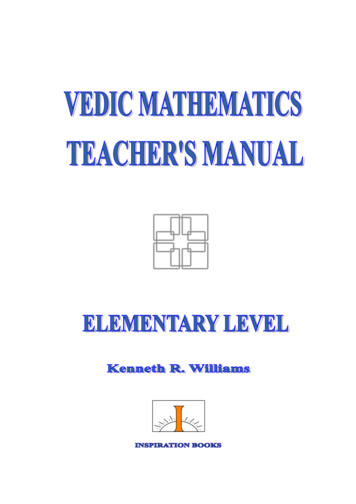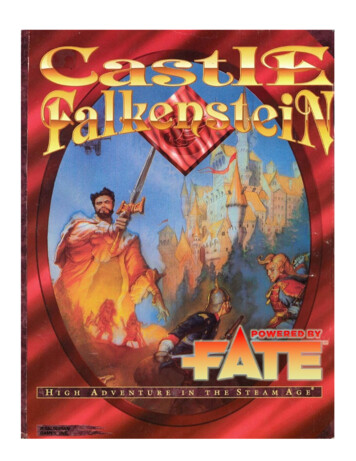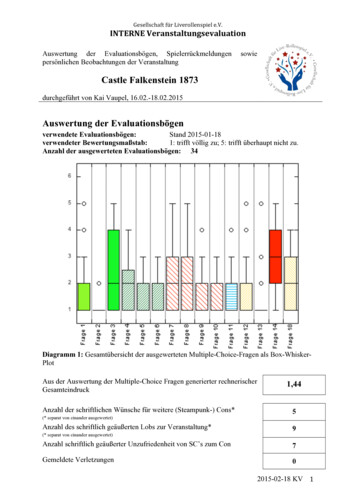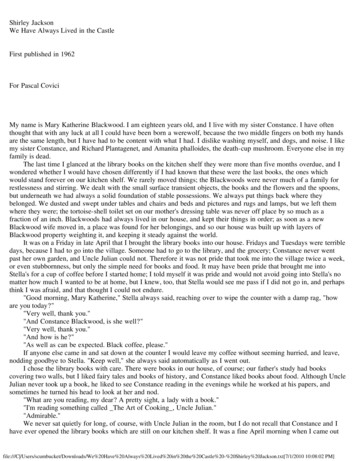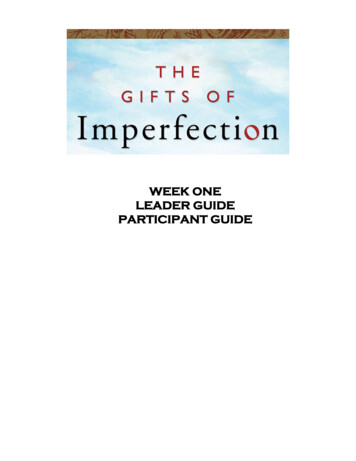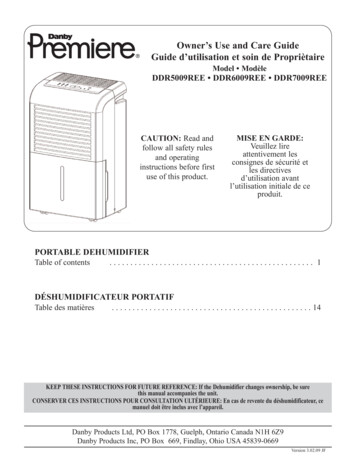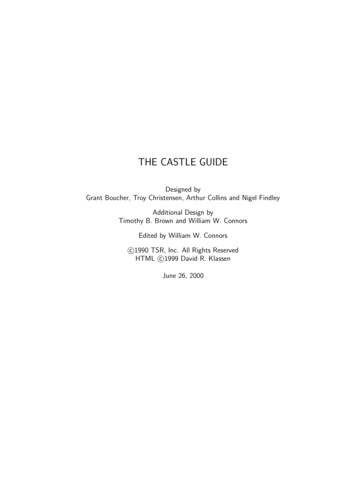
Transcription
THE CASTLE GUIDEDesigned byGrant Boucher, Troy Christensen, Arthur Collins and Nigel FindleyAdditional Design byTimothy B. Brown and William W. ConnorsEdited by William W. Connorsc 1990 TSR, Inc. All Rights ReservedHTML c 1999 David R. KlassenJune 26, 2000
2
2 In the Days of Knights2.1 Knights of Glory . . . . . . . . . .2.2 Nothing is Free . . . . . . . . . .2.3 War horses . . . . . . . . . . . . .2.4 In Search of High Adventure . . .2.5 Knighthood for Non-Warriors . . .2.6 The Road to Knighthood . . . . .2.7 Questing for Knighthood . . . . .2.8 Any Excuse for a Party . . . . . .2.9 Demi-Human Celebrations . . . . .2.10 The Chivalric Code . . . . . . . .2.10.1 Medieval Code of Chivalry2.10.2 A Modern Code of Chivalry2.11 Maid to Fit . . . . . . . . . . . .2.12 Falling from Grace . . . . . . . . .2.12.1 Loss of Personal Honor . .2.12.2 Loss of Family Honor . . .2.12.3 Loss of Royal Honor . . . .2.13 Rogue Knights . . . . . . . . . . .2.14 Heraldry . . . . . . . . . . . . . .2.14.1 Standards . . . . . . . . .2.14.2 The King’s Standard . . .2.14.3 Altering the Armor Further2.15 Demi-Human Knights . . . . . . .2.15.1 Elven Knights . . . . . . .2.15.2 Dwarven Knights . . . . .Contents1 al SettingMerging Fact and Fantasy . . . . .Notes on Campaign Politics . . . . .Feudal Society . . . . . . . . . . . .Social Classes . . . . . . . . . . . .1.4.1 Serfs . . . . . . . . . . . . .1.4.2 Yeomen . . . . . . . . . . .1.4.3 Tradesmen . . . . . . . . . .1.4.4 Guildsmen . . . . . . . . . .1.4.5 Chivalrics . . . . . . . . . .1.4.6 Nobility . . . . . . . . . . .1.4.7 Royal Family . . . . . . . . .1.4.8 The Imperial Family . . . . .Members of the Court . . . . . . . .1.5.1 Lord High Chamberlain . . .1.5.2 Lord High Chancellor . . . .1.5.3 Lord High Justice . . . . . .1.5.4 Lord High Marshal . . . . .1.5.5 Lord High Inquisitor . . . . .1.5.6 Lord High Wizard . . . . . .1.5.7 Lord High Chaplin . . . . . .A Note About Magic . . . . . . . .The Role of The Church . . . . . .1.7.1 Lay Brethren . . . . . . . . .1.7.2 Acolytes . . . . . . . . . . .1.7.3 Postulant . . . . . . . . . .1.7.4 Priest . . . . . . . . . . . .1.7.5 Curate . . . . . . . . . . . .1.7.6 Dean . . . . . . . . . . . . .1.7.7 Primate . . . . . . . . . . .1.7.8 High Priest . . . . . . . . .1.7.9 Patriarch . . . . . . . . . . .Politics And Churches . . . . . . . .1.8.1 The Divine Right of Kings .1.8.2 Politics Within The Churches1.8.3 Conflicting Faiths . . . . . .1.8.4 The Church and Magic . . .Crimes and Punishments . . . . . .1.9.1 Violent Crimes . . . . . . . .1.9.2 Crimes of Theft . . . . . . .Death by Taxes . . . . . . . . . . .1.10.1 Everyday Taxes . . . . . . .1.10.2 Monthly Taxes . . . . . . . .1.10.3 Legal Fees and Duties . . . .Populating the Castle . . . . . . . .Paying for Your Castle or Kingdom .1.12.1 Bribery is Your Friend . . . .A Day in the Life of a Peasant . . 131313131314141516161617181919193 The3.13.23.33.43.53.63.7TournamentHigh Holidays . . . . . . . .Private Celebrations . . . . .Tests . . . . . . . . . . . . .Challenges . . . . . . . . . .Local Fairs . . . . . . . . . .Noble Tournaments . . . . .Jousting . . . . . . . . . . .3.7.1 Quick Jousting Rules3.8 Archery . . . . . . . . . . .3.8.1 Quick Archery Rules .3.9 Holy Debates . . . . . . . .3.10 Wizardry Competitions . . .4 The4.14.24.3.29292929293030303031313131Evolution of Castles33The Castle’s Role . . . . . . . . . . . . . . 33Types Of Castles . . . . . . . . . . . . . . . 33Technological Levels . . . . . . . . . . . . . 335 Castle Construction5.1 Acquiring Land . . . . . . . . .5.1.1 Royal Charters . . . . . .5.1.2 Land Grants . . . . . . .5.1.3 Conquest of Land . . . .5.1.4 Purchasing Land . . . . .5.1.5 Claiming Land . . . . . .5.1.6 Theft or Claim Jumping .5.1.7 Leasing . . . . . . . . . .5.2 The Construction Site . . . . . .5.2.1 Climate Type . . . . . .5.2.2 Temperate (1.25) . . . .5.2.3 Geography . . . . . . . .5.2.4 Ground Cover . . . . . .5.2.5 Resource Availability . .5.3 The Work Force . . . . . . . . .5.3.1 Local Social Structure . .5.3.2 Worker Skill . . . . . . 72728.373737373737373838383838393940404041
4CONTENTS5.45.55.65.75.85.3.3 Worker Morale . . . . . . . . . .Determine the Final Production Modifier5.4.1 Castle on the Moors . . . . . . .Castle Design . . . . . . . . . . . . . .5.5.1 Castle Modules . . . . . . . . .5.5.2 Module Descriptions . . . . . . .Laying out the Castle . . . . . . . . . .5.6.1 Castle on the Moors . . . . . . .Average Construction Time & Cost . . .5.7.1 Works of Art . . . . . . . . . .5.7.2 Overhead Costs . . . . . . . . .5.7.3 Final Calculations . . . . . . . .5.7.4 Castle on the Moors . . . . . . .The Work Force . . . . . . . . . . . . .5.8.1 Larger Work Forces . . . . . . .5.8.2 Smaller Work Forces . . . . . .5.8.3 Heroic Characters . . . . . . . .5.8.4 Magical Items . . . . . . . . . .5.8.5 Monsters . . . . . . . . . . . . .5.8.6 Work Seasons . . . . . . . . . .41424242424345454646464646464647474747485.95.8.7 Castle on the Moors . . . . . . . . .Monthly Events . . . . . . . . . . . . . . .5.9.1 Castle on the Moors . . . . . . . . .6 Unusual Castles6.1 Oriental Designs . . . . . . . .6.2 Thieves’ Castles . . . . . . . .6.3 Wizards’ Keeps . . . . . . . .6.4 Priests’ Fortresses . . . . . . .6.5 Paladins’ Castles . . . . . . . .6.6 Rangers’ Forts . . . . . . . . .6.7 Druids’ Shrines . . . . . . . .6.8 Dwarven Citadels . . . . . . .6.8.1 Kiva Design . . . . . .6.8.2 Pit and Cistern Design6.9 Elven Sanctuaries . . . . . . .6.9.1 Green Labyrinth . . . .6.9.2 Blue Circle . . . . . . .6.10 Halfling Strongholds . . . . . .6.11 Gnomish Castles . . . . . . . .6.12 Orcish Keeps . . . . . . . . . .4848505353535354545455555555565656565757
IntroductionPrepare yourself for a voyage back in time.As you read this book, you will be drawn back throughthe years to an age when castles dominated the landscapeof Europe. Here, amid these mighty stone halls, you willfind knights in shining armor and great battles fought bymen and women with steel swords and iron nerves.Welcome to the Age of Chivalry.Here, we expand upon the BATTLESYSTEM rules andprovide rules for resolving long sieges and the defense ofcastles. Material in this section addresses the elements of afantasy world that make defending a castle more than justan exercise in historical simulation. In addition, we lookat the various types of castles found in the AD&D game,including those of the dwarves and elves. If you aren’t interested in fighting out individual battles with miniatures,we have taken care to include a pair of quick resolutionsystems (cf. Section ?). The first of these can be used toresolve individual sieges, while the second can be employedto determine the victor in an individual battle or all-outmilitary campaign.Lastly, we have included a trio of generic castles (cf.Section ?) for use by the Dungeon Master in setting uphis game. If time is tight, any one of these structures canbe easily adapted to serve as an NPC’s base of operationsor as a model of medieval design techniques.What’s in this book?The Castle Guide is an outgrowth of the AD&D 2nd edition game rules. In the DUNGEON MASTER Guide andPlayer’s Handbook a general rules system was establishedthat allows the Dungeon Master to run a variety of fantasyrole-playing styles. In this book, however, we will focus inon a specific style of game, one set in a society similar tothat of feudal Europe, and give you the background information you need to make it come to life. The first section(cf. Section 1) of this book begins with an overview ofmedieval society and the feudal system in general. Here,you will come to understand the forces that drive a feudalgovernment and the relationship between the state and itschurches.Following this, we go on to detail the ways in whichplayer characters can become knights (cf. Section 2), thestout defenders of the realm. The code of chivalry is examined and the standards by which a knight must live hisor her life are addressed. In closing the first section, we offer a guide to medieval tournaments (cf. Section 3). Here,characters get the chance to show off their skills and try forthe hand of the beautiful princess (or handsome prince).Our second section (cf. Section 4) examines the evolution of castles in medieval Europe and provides an overviewof their advantages and disadvantages. Following that, wepresent a modular system for the design and constructionof castles (cf. Section 5) for use by Player Characters andNPCs alike. With this simple system, the DM can determine just how much it will cost a character to build thekeep of his dreams and how long the construction will take.Included with this are rules for the use of magical items andmonsters in the building process.For those of you who are fond of theBATTLESYSTEMT M miniatures rules, we have includedthe third portion (cf. Section ?) of The Castle Guide.Using The Castle GuideAs you can see, there is a great deal of information in thisbook. Of course, you can use as much or as little of it as youwant in your AD&D game. If you are using the CompleteFighter’s Handbook in your campaign, you will find thatmuch of the information in this book works well with thecavalier and swashbuckler kits especially. However, anyonewho runs a campaign that has elements of feudal Europein it will find something of value to them in this book.For those who want to set their campaign against thebackdrop of a great war, as was done in Tolkien’s Lord ofthe Rings trilogy, the quick resolution systems presented inChapter 8 (cf. Section ?) will allow players to focus on therole-playing aspects of the game, while still being able tochange the course of a battle or turn the tide of an entirewar.If you enjoy wargames and want to mesh your AD&Dgame campaign more fully with your BATTLESYSTEMgames, the sections on warfare will also provide you withlots of information for new scenarios. With the addition ofthe material in this book, role-playing’s premier miniaturesrules system reaches new heights.Knights, mount your horses. The time for battle is athand!5
6CONTENTS
Chapter 1The Feudal Setting1.1Merging Fact and Fantasythe majority of first level adventurers are not able to copewith problems like major wars, thwarting the ultimate evil,or slaying that most horrible of horrors, the dragon. At thispoint in their careers, the characters are not going to beoverly concerned with the ramifications of the king’s political alliances for the same reason that most of us are notexperts in the details of our country’s own foreign relations:it simply doesn’t enter into our daily lives.As they progress in levels, however, things will begin tochange. At first, this will be only a passing thing. Perhapsone adventure brings their actions to the attention of a local baron who, for better or worse, makes a mental noteto keep an eye on the characters. By the time they havereached ninth level, the characters are usually fairly wellknown and have acquired the status of folk heroes. As hebegins to attract followers, the character cannot help butcome to the attention of the local government.It is almost certain that, given time, they will becomeas well known in their homelands (or the region in whichthey adventure) as George Washington, Abraham Lincoln,or the Wright brothers are in the modern United States.Of course, this may also mean that they are expected toundertake tasks which seem impossible and confront unstoppable armies as a matter of routine duty to their king.Oh well, that’s what they get for giving up the simple lifeof a blacksmith.In any case, it is important to note that relationshipswith the local nobility (even for those who are a part ofit) are not always cordial. Just as the king can be a veryvaluable friend, so too can he be a deadly adversary.Many of us got into role-playing games when we met somefriends who simply asked us to “come by and watch.” Littledid we know that we had already watched plenty of roleplaying games in our all too short lives. In fact, the filmsand novels we’ve read over the years hold that same sparkof imagination that drew us into these crazy games in thefirst place.When setting up a new campaign world, there are twobasic schools of thought: those who feel the game shouldbe very historically accurate and those who do not. Ofcourse, the introduction of magic into the historic world isa mainstay of the AD&D game and cannot help but distortan otherwise historic setting.So, which do you choose in your campaign? Is yourworld going to be classically accurate, as it was seen in thegreat Roman and Biblical epics we’ve all watched on TV?Or will the world have an element of magic and superstitionlurking just out of sight (or even in full view), like the greatepic stories of Excalibur and Conan the Barbarian?If you choose the latter, you must decide how far totake the magic. Very popular in recent fantasy literatureare the “no holds barred” magical worlds where everyoneand their brother lives and breathes magic. In many ways,this is similar to the way in which the average person seestechnology today. After all, most people have no idea howa television set works, but they accept it as
Player’s Handbook a general rules system was established that allows the Dungeon Master to run a variety of fantasy role-playing styles. In this book, however, we will focus in on a speci c style of game, one set in a society similar to that of feudal Europe, and give you the background infor-mation you need to make it come to life. The rst section (cf. Section 1) of this book begins with an .
